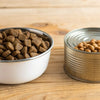What Is Better for a Dog: Wet or Dry Food?
- Houndsy
Table of Contents
- Introduction
- The Basics of Dog Food Types
- Nutritional Differences: Wet vs. Dry Dog Food
- Advantages of Wet Dog Food
- Advantages of Dry Dog Food
- Special Considerations for Each Type
- Transitioning Between Wet and Dry Food
- Conclusion
Introduction
Did you know that approximately 60% of dog owners face the dilemma of choosing between wet and dry food for their furry companions? As pet parents, we all want to provide the best nutrition for our beloved dogs, but the variety of options can be overwhelming. With so many brands and formulas available on the market, it’s essential to understand the primary differences between wet and dry dog food to make an informed decision.
In this blog post, we will explore the nutritional benefits, convenience, palatability, and specific health considerations associated with both wet and dry dog food. By the end of this article, we hope to clarify your understanding and help you determine what is best for your dog's unique needs. So, let’s dive in and reflect on our own feeding routines as we navigate through this important topic!
The Basics of Dog Food Types
To begin, let's clarify what we mean by wet and dry dog food:
- Wet Dog Food: Typically packaged in cans or pouches, wet food contains a high moisture content (usually around 75-85%). It has a softer texture, making it easier for dogs, especially seniors or those with dental issues, to chew and digest.
- Dry Dog Food: Often referred to as kibble, dry food has a much lower moisture content (around 5-10%). It is usually packaged in bags and has a crunchy texture, which can aid in dental health due to the chewing action required.
Understanding these definitions is crucial as we explore the specific benefits and considerations of each type.
Nutritional Differences: Wet vs. Dry Dog Food
When it comes to nutrition, both wet and dry dog food can be formulated to meet the dietary needs of dogs. However, there are notable differences in their nutritional profiles.
Moisture Content
One of the most significant distinctions between the two is moisture content. Wet food is an excellent source of hydration, which is beneficial for dogs that may not drink enough water throughout the day. This can be particularly important for dogs with urinary tract issues or those prone to kidney problems. On the other hand, dry food typically requires dogs to drink more water to stay hydrated.
Protein and Fat Levels
Both wet and dry foods can be rich in protein, but the actual content varies based on individual brands and formulations. Generally, wet dog food tends to have a higher protein content due to the inclusion of real meat and fewer fillers. However, it's essential to examine the protein percentage on a dry matter basis to make a fair comparison between wet and dry options.
Additionally, fat content varies between the two types, with some wet foods containing higher fat levels to enhance flavor and palatability. Conversely, high-quality dry foods often include healthy fats that support skin and coat health.
Carbohydrate Composition
Dry dog food usually contains a higher carbohydrate percentage compared to wet food. These carbohydrates are necessary for the cooking process and help bind the kibble. However, an excess of carbohydrates can lead to weight gain, so it's essential to select a food that offers a balanced approach to nutrition.
Advantages of Wet Dog Food
Enhanced Palatability
One of the most significant advantages of wet dog food is its flavor and aroma. The rich, meaty scent is often irresistible to dogs, making it an excellent choice for picky eaters or dogs recovering from illness. If you've ever struggled to get your dog to eat, you might find that introducing wet food can reignite their appetite.
Hydration Benefits
Wet food's high moisture content can significantly contribute to your dog's hydration levels. If your dog doesn’t drink enough water, incorporating wet food into their diet can help keep them hydrated, promoting overall health and well-being.
Easier to Chew
For senior dogs or those with dental issues, wet food can be easier to chew and digest. The softer texture allows them to enjoy their meals without discomfort, ensuring they continue to receive essential nutrients.
Advantages of Dry Dog Food
Convenience and Cost-Effectiveness
Dry dog food is often more convenient for pet owners. It’s simple to measure, store, and serve without worrying about spoilage. Unlike wet food, which needs to be refrigerated after opening, dry food can be kept in a sealed container for extended periods without losing freshness.
Additionally, dry kibble tends to be more cost-effective over time. Because it is more nutrient-dense due to its lower moisture content, you generally get more nutrition per pound compared to wet food.
Dental Health Benefits
The crunchy texture of dry dog food can help remove plaque from your dog’s teeth, reducing the buildup of tartar and promoting better oral health. While it shouldn’t replace regular dental care, kibble can contribute to maintaining a healthy mouth.
Easier Portion Control
Measuring dry food is a straightforward process, allowing for precise portion control. This can be particularly beneficial when managing your dog’s weight or adjusting their diet based on activity levels.
Special Considerations for Each Type
When deciding between wet and dry dog food, it's vital to consider your dog's specific needs and lifestyle.
Health Conditions
For dogs with certain health conditions, one type of food may be more beneficial than the other. For example, dogs suffering from urinary tract issues may benefit from wet food due to the additional moisture it provides. Conversely, dogs with dental problems might find dry food easier to manage.
Age and Life Stage
A dog’s age can also influence the best type of food. Puppies typically need higher calorie content and a rich nutrient profile for growth, while senior dogs may require lighter options that are easier to digest. It’s essential to choose a food that aligns with their life stage.
Mixing Wet and Dry Food
Many pet parents find success in offering a combination of wet and dry food to their dogs. This approach can provide the best of both worlds, enhancing palatability while offering the nutritional benefits of each type. Mixing can also encourage dogs to eat more if they're feeling finicky.
Transitioning Between Wet and Dry Food
If you decide to switch your dog’s food type, it’s crucial to do so gradually. Rapid changes in diet can lead to digestive upset. Here are some tips for a smooth transition:
- Introduce Slowly: Begin by mixing a small amount of the new food with their current food, gradually increasing the proportion of the new food over 7-10 days.
- Monitor Their Response: Keep an eye on their appetite, stool consistency, and overall behavior during the transition. If any issues arise, consult your veterinarian.
- Consult Your Vet: Always check with your veterinarian before making significant dietary changes, especially if your dog has health conditions or specific dietary requirements.
Conclusion
Ultimately, the choice between wet and dry dog food depends on your dog’s individual needs and preferences. Wet food offers hydration, enhanced palatability, and ease of chewing, while dry food provides convenience, cost-effectiveness, and potential dental health benefits. Many dog owners find that a mix of both types allows them to meet their pet’s nutritional needs while keeping mealtime exciting.
As responsible pet parents, we have the power to elevate our dog’s feeding experience. By choosing high-quality food that aligns with our pup’s health and lifestyle, we can ensure they thrive. To complement your dog's feeding routine, we invite you to explore the Houndsy Kibble Dispenser, designed to make feeding convenient, consistent, and beautiful.
FAQ
1. Is wet food better than dry food for dogs?
Both wet and dry foods have their benefits, and the best choice depends on your dog's individual needs. Wet food is great for hydration and palatability, while dry food is convenient and can support dental health.
2. Can I mix wet and dry dog food?
Yes! Mixing both types can provide a variety of textures and flavors, helping to keep mealtime interesting for your dog while also delivering nutrition from both sources.
3. How do I transition my dog to a new food?
Gradually mix the new food with your dog's current diet over 7-10 days, monitoring their reaction and making adjustments as needed.
4. What should I look for in a good dog food?
Choose a food that lists high-quality, digestible ingredients and meets the nutritional needs for your dog’s age, size, and health condition.
5. Can I use wet food as a treat?
Absolutely! Wet food can be used as a topper for dry kibble or offered as a treat, especially for dogs that are picky eaters or need a little extra motivation to eat.












